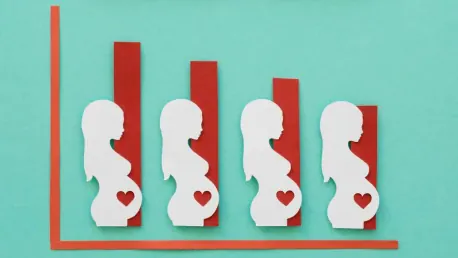In a controversial move that has stirred a political hornet’s nest, Sean Duffy, the newly appointed transportation secretary under President Trump, has issued a directive that prioritizes transportation grants for communities boasting higher-than-average marriage and birth rates. As soon as Duffy’s confirmation was finalized, the directive was disseminated, prompting an uproar primarily from Democratic lawmakers. This new policy is perceived by many as an attempt to economically favor Republican-majority states at the expense of Democratic-leaning regions, which typically feature lower fertility and marriage rates.
Directive Overview
The directive does not stop at marriage and birth rates; it also stipulates that recipient governments must reject vaccine and mask mandates and demonstrate cooperation with the administration’s immigration enforcement efforts. This complex set of requirements appears to be designed to strategically benefit Republican-majority states. These states, known for higher fertility and marriage rates, would ostensibly be in a better position to receive funds compared to their Democratic counterparts, who tend to enforce stricter public health regulations and favor more liberal policies on immigration.
The announcement of this directive has been met with fierce criticism from several Democratic leaders. Connecticut Democratic Sen. Richard Blumenthal didn’t mince words as he likened the policy to “social engineering,” drawing a provocative parallel to the People’s Republic of China. Blumenthal argued that the directive targets blue states, coercing them into conforming to the administration’s stances on contentious issues like tolls, vaccines, and immigration. Washington Democratic Sen. Patty Murray echoed these sentiments, describing the directive as “disturbingly dystopian.” Meanwhile, U.S. Rep. Kweisi Mfume from Maryland expressed concerns over existing grants sanctioned under the Biden administration being jeopardized by this new policy.
Implications for Different States
Analyzing the statistical data reveals a stark geographical divide; higher birth rates are predominantly found in states that supported Trump during the election, notably in the South and Midwest. Conversely, states that rallied behind Democrat Kamala Harris, mainly in the Northeast and along the West Coast, tend to have lower marriage and birth rates. By focusing on these demographic factors, the directive could significantly redirect transportation funds from blue states, historically with lower birth and marriage rates, towards red states with higher rates. Tennessee Republican Sen. Marsha Blackburn justified this move by pointing to population shifts from blue to red states, which she argues necessitates a reevaluation of funding priorities.
However, this unusual approach to transportation funding raises eyebrows among experts. Kevin DeGood from the Center for American Progress criticized the criteria as “bizarre and a little creepy.” He contends that aging populations shouldn’t be excluded from receiving transportation investments merely because they have lower birth rates. Sarah Hayford, a sociology professor at Ohio State University, was equally surprised, pointing out that policy typically addresses barriers to childbearing rather than rewarding those already having children. She also highlighted that higher birth rates correlate with regions where education levels are generally lower. Beth Jarosz from the Population Reference Bureau further argued that birth rates might not be a suitable metric for assessing family support, as families often move once their homes no longer accommodate their growing numbers.
Political and Legal Considerations
The timing of this memorandum is pivotal. With hundreds of billions of dollars allocated for infrastructure by the 2021 bipartisan law still unspent, the discretionary power sought through Duffy’s directive could substantially influence where these funds end up. Legal experts predict this could trigger a wave of legal challenges. If affected communities feel the funding criteria have inflicted an illegal disparate impact on them, they may seek judicial intervention. Historically, administrations have wielded extensive authority over grant distribution criteria, but the ambiguity of this directive could lead to a myriad of contested denials.
Despite the clear intent of the directive to reallocate funds to red states, several demographic anomalies exist, such as San Diego and Sacramento, which boast higher birth rates compared to other parts of California. Legal experts stress that the courts may have a difficult time determining if the memo should be struck down. Additionally, there is still uncertainty about how this directive could impact grants that were previously allocated during the Biden administration. It’s too early to tell, and much will depend on the legal back-and-forth and administrative decisions that follow.
Political and Social Engineering Concerns
Many critics view the directive as less about transportation and more about pushing a broader social agenda. Sen. Blumenthal suggested the directive is an attempt to mask an underlying strategy to reward red states and penalize blue states for their divergent policy stances. This view posits that the Trump administration aims to pressure blue states into alignment with its ideology on family values, public health mandates, and immigration policies. The Trump administration has not yet provided detailed responses to these criticisms or explained the specific rationale behind the directive’s criteria.
Moreover, the directive lacks the legal backing that statutes or formal regulations possess, leading to potential challenges in its enforcement and effectiveness. The seemingly arbitrary nature of choosing birth and marriage rates as funding criteria could be viewed as discriminatory, leading to significant debate. Initial reactions suggest widespread opposition, particularly if essential infrastructure projects in blue states, such as improving Baltimore’s U.S. 40, are perceived to be at risk.
Current and Potential Legal Framework
Attorneys like Joel Roberson, who specialize in transportation and infrastructure legal challenges, emphasize the broad but generally accepted authority administrations have to set funding priorities. However, the explicit linkage to birth and marriage rates might face legal challenges. Affected communities could argue that the directive imposes an “unjust disparate impact,” questioning whether it aligns with federal anti-discrimination laws. Courts will likely play a crucial role in interpreting whether this directive upholds or violates such principles.
Through its selection of marriage and birth rates as determining factors, the directive raises profound questions about fairness and discrimination. This directive’s implementation remains uncertain, with the potential for significant impact on existing infrastructure projects heavily debated. The broader societal implications extend beyond transportation, touching on the ideological conflicts that continue to polarize the nation.
Conclusion
In a divisive move that has sparked significant political debate, Sean Duffy, newly appointed as the transportation secretary under President Trump, has issued a controversial directive. This directive prioritizes transportation grants for communities with higher-than-average marriage and birth rates. Following Duffy’s confirmation, the directive was quickly disseminated, causing an uproar, especially among Democratic lawmakers. Many perceive this new policy as an effort to economically benefit Republican-majority states, which often have higher fertility and marriage rates, while disadvantaging Democratic-leaning areas that typically show lower rates in these metrics. The directive has ignited concerns of unequal resource allocation, polarizing opinions even further in an already heated political environment. Lawmakers on both sides are debating the implications of this move, questioning its fairness and potential impact on future transportation projects across the country. The controversy continues as stakeholders and communities await further developments.









